Intel SSD 525 Review (240GB)
by Anand Lal Shimpi on January 30, 2013 1:42 AM ESTRandom Read/Write Speed
The four corners of SSD performance are as follows: random read, random write, sequential read and sequential write speed. Random accesses are generally small in size, while sequential accesses tend to be larger and thus we have the four Iometer tests we use in all of our reviews.
Our first test writes 4KB in a completely random pattern over an 8GB space of the drive to simulate the sort of random access that you'd see on an OS drive (even this is more stressful than a normal desktop user would see). I perform three concurrent IOs and run the test for 3 minutes. The results reported are in average MB/s over the entire time. We use both standard pseudo randomly generated data for each write as well as fully random data to show you both the maximum and minimum performance offered by SandForce based drives in these tests. The average performance of SF drives will likely be somewhere in between the two values for each drive you see in the graphs. For an understanding of why this matters, read our original SandForce article.
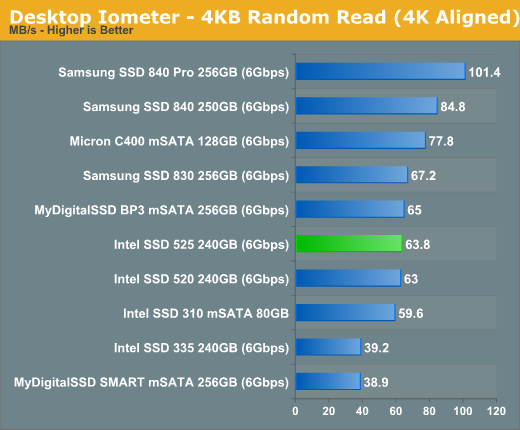
Random read performance is basically identical to the 520, and middle of the pack compared to other SSDs here. If we limit the comparison to just mSATA drives, only Micron's C400 does a better job.
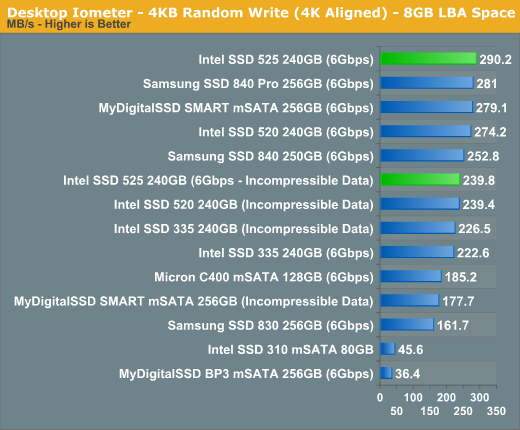
Random write performance with data that's easily compressed is a clear win for the 525. It's clear the Intel has done some work under the hood as the 525 even outpaces the 520 here. Even when faced with incompressible data, the 525 does quite well (although its advantage over the 520 disappears).
Many of you have asked for random write performance at higher queue depths. What I have below is our 4KB random write test performed at a queue depth of 32 instead of 3. While the vast majority of desktop usage models experience queue depths of 0 - 5, higher depths are possible in heavy I/O (and multi-user) workloads:

SandForce drives do a good job scaling with queue depth and we see the 525 behave as expectedly here. Both it and the 520 converge to the same performance levels.
Sequential Read/Write Speed
To measure sequential performance I ran a 1 minute long 128KB sequential test over the entire span of the drive at a queue depth of 1. The results reported are in average MB/s over the entire test length.

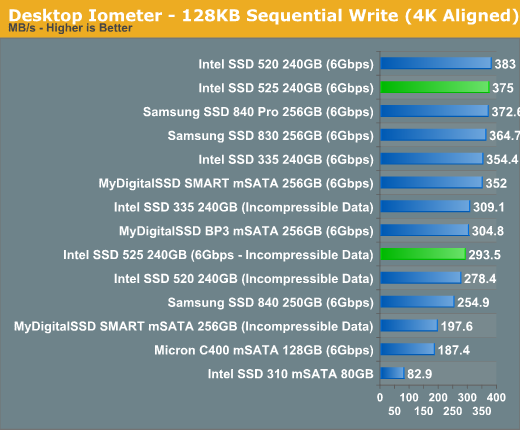
Sequential performance is once again near identical to the 520, with the 520 pulling ahead in sequential writes.
AS-SSD Incompressible Sequential Performance
The AS-SSD sequential benchmark uses incompressible data for all of its transfers. The result is a pretty big reduction in sequential write speed on SandForce based controllers.
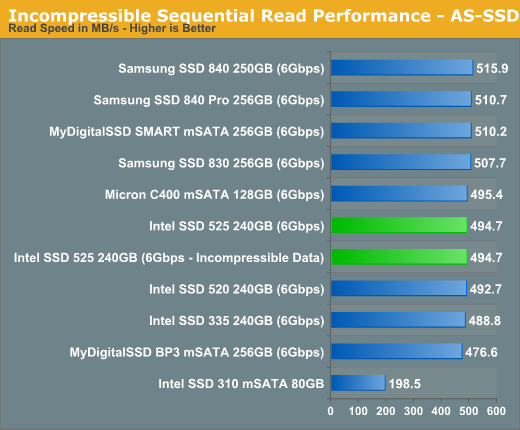
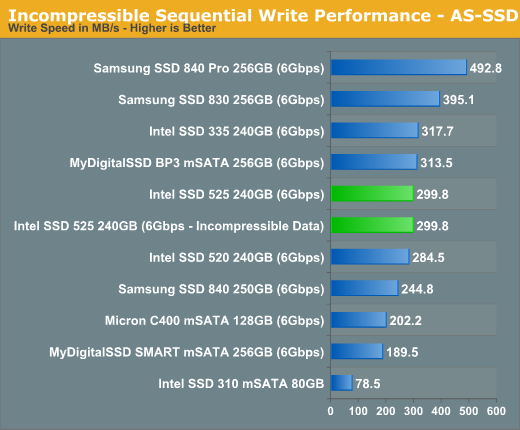
Incompressible performance is very similar to the 520, although once again the 525 does pull ahead slightly.










21 Comments
View All Comments
philipma1957 - Wednesday, January 30, 2013 - link
meaker10 have you used a msi gt60?critical_ - Wednesday, January 30, 2013 - link
I'm using Startech's SAT2MSAT25. It is a "passthrough" design so it'll work at 6Gbps is your controller supports it.HyperJuni - Wednesday, January 30, 2013 - link
I was hoping for a comparison with the m4/C400 mSATA 256GB, since it seems to differ a bit in performance from the 128GB model, and would be better suited as a "direct competitor" to the 240GB 525 for the same of comparison IMHO.Too bad you didn't include it in the charts, Anand.
nathanddrews - Wednesday, January 30, 2013 - link
Since IOPS consistency improves significantly when setting aside 25% spare area, what is the practical effect in real world? Has this been documented using the AT Storage Bench? Under default conditions, the 840 Pro dominates the top of the charts, but does it still retain the crown after being "stroked"? Just curious...SanX - Wednesday, January 30, 2013 - link
Is it burning hot for its size? Will it fry your eggs?SanX - Wednesday, January 30, 2013 - link
damn cellphone spell-correction typo and lack of edit option like on cheap websites: ***incompressible***dealcorn - Wednesday, January 30, 2013 - link
The prospect of the S3700 technology in a consumer drive has appeal except that the S3700 uses too much power. Is Intel's approach inherently inefficient or is it reasonable that Intel can tune the technology differently for the consumer market to achieve competitive efficiency?name99 - Wednesday, January 30, 2013 - link
"Why does Intel continue to use a third party SATA controller in many of its flagship drives? Although I once believed this was an issue with Intel having issues on the design front, I now believe that a big part of it has to do with the Intel SSD group being more resource constrained than other groups within the company.
"
This seems strangely short sighted. How is flash controlled on mobile devices?
Obviously performance is substantially lower. It's not clear to me how that lowering is split between
- cheaper, lower-end flash
- only one rank (or whatever flash their call their equivalent), ie limited parallelism
- a dumb controller.
However there doesn't seem to be any aspect of the problem that is inherently power limited.
Which implies that if Intel wanted a way to make their perpetually lagging Atom SOCs a little more noteworthy, one way to do so would be to work on them having flash support that was substantially faster than what's available on ARM today.
emvonline - Thursday, January 31, 2013 - link
Sandforce controllers are high performance, have no DRAM need, and allow both SF standard and custom firmware. Until SF drops the ball on performance or support I would look for more SSDs to be based on the SF design, not less. Enterprise is different ball game where ASPs/margins are much higher so custom controller might make sense (volumes are much lower though). If other 3rd party controllers mature, I expect them to gain market share as well.damnintel - Wednesday, March 13, 2013 - link
heyyyy check this out damnintel dot com